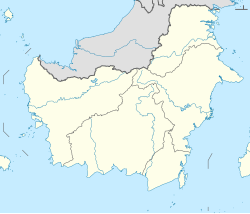Top Qs
Timeline
Chat
Perspective
Sintang Regency
Regency in West Kalimantan, Indonesia From Wikipedia, the free encyclopedia
Remove ads
Sintang Regency is a regency of West Kalimantan province of Indonesia. It covers an area of 21,638.2 km2, and had a population of 364,759 at the 2010 Census[2] and 421,306 at the 2020 Census;[3] the official estimate as at mid 2024 was 443,684 (comprising 228,753 males and 214,931 females).[1]
Sintang Regency is one of the few Indonesian regencies having a land border with another country (in this case, with Malaysia). It is also the third largest regency in the province by land area after Kapuas Hulu Regency and Ketapang Regency. The regency was formerly the site of the Sintang Kingdom, a Hindu kingdom that later converted to Islam and which was a regional power in the interior of Borneo Island. The regency seat is located at the large town of Sintang, which with over 85,000 residents in mid 2024[1] is among the biggest settlements in Borneo's interior alongside Putussibau and Puruk Cahu.
Remove ads
History
Somewhere between 45,000 and 39,000 B.C. the Sintang area was first inhabited by humans. The area changed hands several times from the Majapahit to the Bruneian Sultanate, but the local State of Sintang was ruled by Princes, who became Sultans when converted to Islam in 1672. When the Dutch arrived at Borneo in 1776 the area was quickly occupied by the Dutch.
The area was occupied by the Empire of Japan in 1941 as a result of WW2, and then was liberated in 1945. This was followed by Indonesian Independence.
Remove ads
Geography
Summarize
Perspective
Climate
Sintang, the seat of the regency has a tropical rainforest climate (Af) with heavy to very heavy rainfall year-round.
Remove ads
Administrative districts
Summarize
Perspective
Following the separation of the former southern part (eleven districts) to form the separate Melawi Regency on 18 December 2003, the residual Sintang Regency consists of fourteen districts (kecamatan), tabulated below with their areas and their populations at the 2010 Census[2] and 2020 Census,[3] together with their official estimates as at mid 2024.[1] The table also includes the locations of the district administrative centres, the number of administrative villages in each district (totalling 390 rural desa and 16 urban kelurahan - the latter all in Sintang District), and its post code.
Note: (a) comprising 16 urban kelurahan (Akcaya, Alai, Batu Lalau, Kapuas Kanan Hilir, Kapuas Kanan Hulu, Kapuas Kiri Hilir, Kapuas Kiri Hulu, Kedabang, Ladang, Mekar Jaya, Mengkurai, Menyumbung Tengah, Rawa Mambok, Sengkuang, Tanjung Puri and Ulak Jaya) and 13 desa.
Remove ads
Education
There are 193 kindergartens, 456 elementary schools, 142 junior high schools, and 44 senior high schools. In addition, there are 18 vocational high schools. The regency has a total of 10 universities and higher education institutions as of 2020, most of which are located in the town of Sintang.[6] One of the most notable in the regency is Kapuas Sintang University, located in Sintang District.[7] The university is private and located close to the Kapuas River. It was previously known as Panca Bhakti Teaching and Education College before becoming a university.[8] Muhammadiyah University in Pontianak also has a campus branch in Sintang, which is also private. Other colleges in the regency include Christian theological schools such as Sintang Khatulistiwa Theological College, Injili Setia Sintang Theological College, Kapuas Raya Christian College, and Immanuel Sintang Kalbar Theological College. In addition, there is a public academy owned by the West Kalimantan provincial government and one private Islamic college, Ma'arif Sintang Islamic College.[7]
The regency government also runs a regional library, located in the town of Sintang.[9]
Remove ads
Bibliography
- Fienieg, Anouk, Sejarah Sintang - The History of Sintang : A Collection of Books, Manuscripts, Archives and Articles, 2007
References
Wikiwand - on
Seamless Wikipedia browsing. On steroids.
Remove ads





